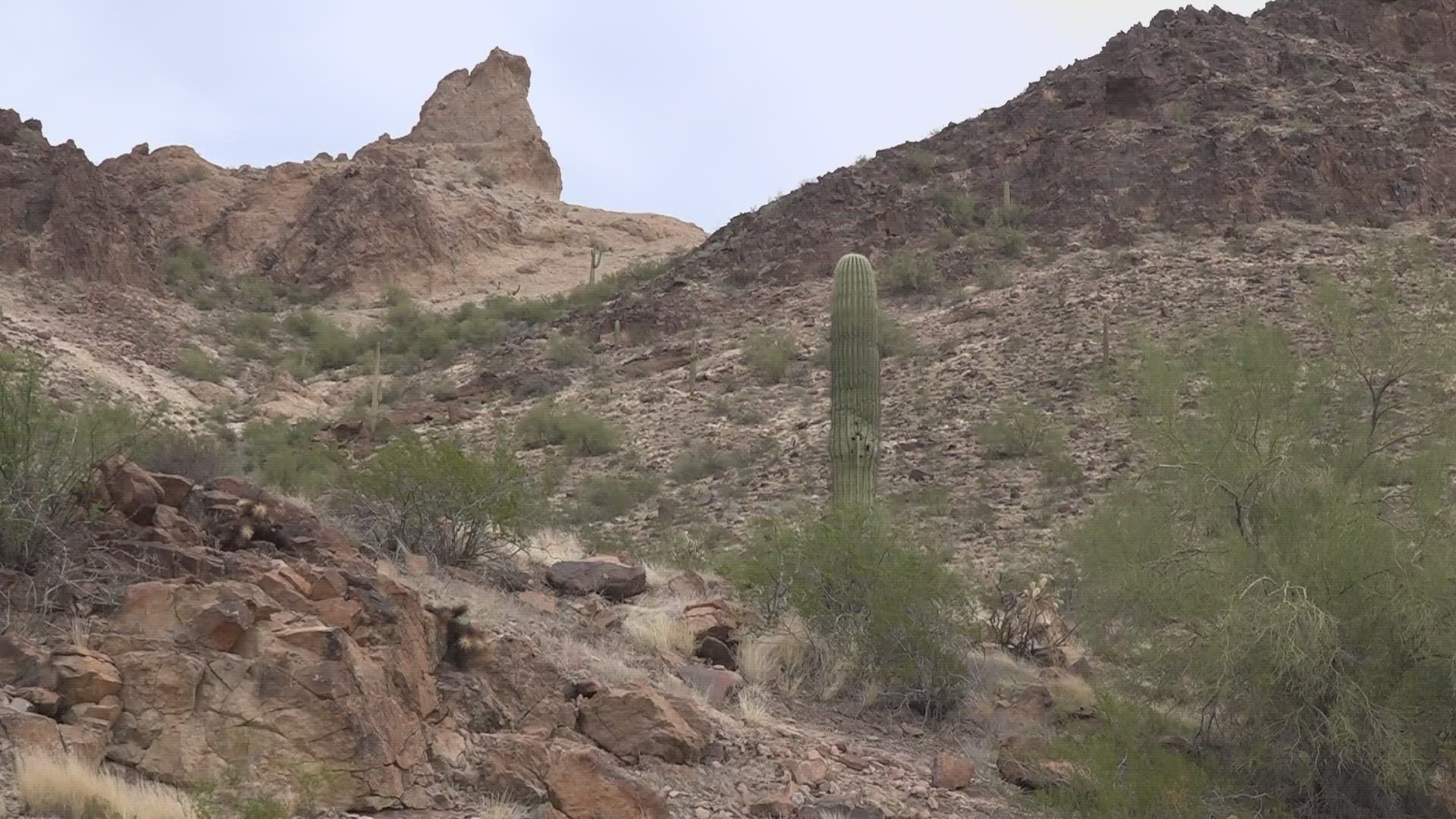TONOPAH, Ariz. — Driving by, it looks like the classic Sonoran Desert, with Saguaro cacti sprinkling the landscape and evidence of desert wildlife on the backdrop of mountain peaks.
But if you know what you're looking for in the 370,000 acres of land encompassed in the Great Bend of the Gila National Monument Proposal, it is rich with cultural and natural resources. Some say those resources need to be protected by the President designating it as a new national monument.
Arizona is built on collisions of the old and the new — Phoenix was founded using ancient Hohokam canals and the growth and building over the past just kept happening. But this is a little different. The West Valley's growth isn't immediately threatening the Great Bend of the GIla, but how people use the land is.
"There needs to be more awareness that you can love a place to death very easily," Skylar Begay, Archaeology Southwest's Director of Tribal Collaboration in Outreach and Advocacy, said.
Begay says this as he walks on an 80-acre parcel of land amidst shotgun shells and broken glass. Those are still left over even after Archaeology Southwest efforts to rehab the land.
Pointing out one petroglyph of the roughly 3,000 Archaeology Southwest has documented at this site, Begay notes the damage to the glyph from target shooting.
It's just one example of the pieces of history from the people who lived here hundreds to thousands of years ago that are being chipped away.
"A lot of people who are descendants of these folks think of them (petroglyphs) more as libraries, because they can understand them, they know what they mean," Begay, who's from the Navajo Nation, said of the glyphs.
Begay describes the land encompassed in the Great Bend of the Gila National Monument Proposal as a nexus for the people who lived here and those who came to meet and trade with them.
In total, 13 tribal sovereign nations have connections to the Great Bend of the Gila, including the Ak-Chin Indian Community, Cocopah Indian Tribe, Colorado River Indian Tribes, Fort McDowell Yavapai Nation, Fort Mojave Indian Tribe, Fort Yuma-Quechan Indian Tribe, Gila River Indian Community, Hopi Tribe, Pueblo of Zuni, Salt River Pima-Maricopa Indian Community, Tohono O’odham Nation, Yavapai-Apache Nation, and Yavapai-Prescott Indian Tribe.
"A part of your spirituality is founded upon the natural landscape," Begay said. "And so when it's desecrated, it's like a part of you, and a part of how you connect to your spirituality is gone. So, it's not a victimless crime."


Beyond the threats of vandalism, theft of cultural resources and target shooting, the growing Valley is also a concern for advocates of seeking protection of the land.
"We feel like this landscape is at risk," Mike Quigley, Arizona State Director for The Wilderness Society, said amidst the backdrop of Saddle Mountain.
Saddle Mountain, about 10 miles southwest of Tonopah, is part of the land advocates would like to see protected.
Quigley has been working to get the land protected since 2010. That started with a legislative proposal for a larger proposal that didn't pass through Congress.
Now, Quigley and others are calling on President Joe Biden to designate Great Bend of the Gila as a national monument. Last August, Biden did the same with Baaj Nwaavjo I’tah Kukveni—Ancestral Footprints of the Grand Canyon National Monument.
"With the National Monument proposal, what we're hoping to do is get ahead of the development curve, and then protect this place for the species that depend on it, but also for the recreational opportunity that offers those of us who live in South Central Arizona," Quigley said.
In the past, Quigley has set remote cameras that have captured images of Desert Bighorn Sheep, Ringtail and other Sonoran Desert species, wanting to show what is here that can be difficult to see.
"It's so alive. It's thriving. It's Arizona, like Arizona used to be," Quigley said.
The designation as a national monument would give extra funding and direction to the Bureau of Land Management to conserve the land permanently, Quigley said.
Begay is hopeful both the national monument designation and tribal co-management of the lands would help people recreate on the land more responsibly by providing for interpretation and education of the public.
"I think the biggest challenge and achieving the goal of having the president create the Great Bend of the Gila national monument is one of timing and to one of competition," Quigley said, noting that there are several other places around the country that are in need of protection.
But both Quigley and Begay believe what's encompassed with the land in the Great Bend of the Gila national monument proposal is worth preserving.
"As climate change becomes more of a stressor for the wildlife that live here, they need connected large landscapes to move around to find resources to find mates to adapt to the stressors of climate change," Quigley said.
"These are non-renewable resources, cultural resources you know, once they're gone, they're gone. So for the descendants of the people who put these petroglyphs on the rocks, I can imagine it's even more. Because I'm Diné, I'm from Navajo Nation. So these are not my traditional homelands, but I still feel just that sadness for what's been lost, right?," Begay said. "And what could be lost if this place isn't protected?"

